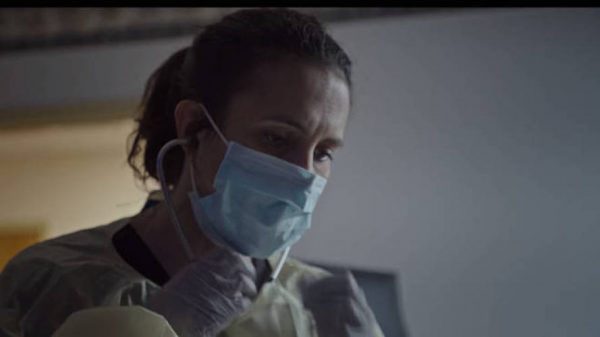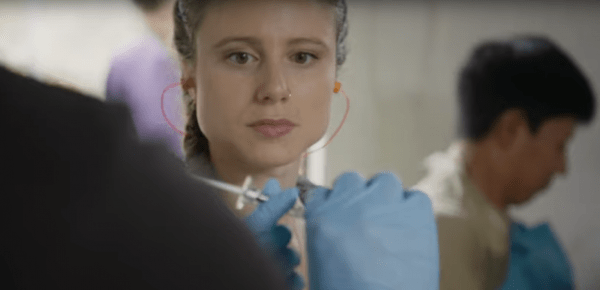WATCH CLOSELY: Netflix’s “Pandemic” is Harrowing, Prescient
By Peg Aloi
The sheer breadth of information presented here will, at the very least, raise public awareness by deepening our understanding of how pandemics work and why it is important to prepare for the inevitable.

A scene from Pandemic: How to Prevent an Outbreak. Photo: Netflix
Timing is everything, is it not? Netflix could not have done better if it had planned it. Its four-part documentary series Pandemic: How to Prevent an Outbreak arrives during one of the worst worldwide pandemics the world has seen in just over a century. Experts have noted often over the past few weeks that the arrival of a deadly global pandemic was not a matter of if, but when — and when is now. Although Pandemic is not specifically about a coronavirus, the show deals with several other kinds of pandemics that have occurred around the world in recent years. It also explores the work being done by prominent and little-known scientists and doctors in the midst of, or in preparation for, various global pandemics, from swine flu to Ebola.
Of course that word “preparation” is problematic just now. In the United States we are seeing the devastating impact following our president’s reckless behavior and decisions. He has left us tragically underprepared for the current Covid-19 pandemic. Indeed, some of the talking heads featured in Pandemic are the very same people we are seeing on the news frequently these days, including Ron Klain, a former chief of staff to Vice Presidents Gore and Biden, and the coordinator of an early response team to the Ebola pandemic in 2014-15.
Each episode, co-directed by Isabel Castro (a former producer for Vice News Tonight) and Doug Shultz (director of Chasing Life and many other docuseries), runs just under an hour and has a different focus. Topic areas are divided into sub-chapters, which are made up of individual stories. There’s quite a lot of material covered here and a number of players, but the narrative structure moves with efficiency between different locations (in the USA, Africa, India, and Guatemala), people, and events, encouraging intriguing connections and insights.

A scene from Pandemic: How to Prevent an Outbreak. Photo: Netflix
For example, there’s Syra Madad, a New York based doctor who saw the ’90s film Outbreak, the story of a deadly airborne pandemic fought by the US army, when she was a teenager. That led her to decide to devote her life to pandemic preparedness. Her daily activities range from asking politicians for funding and giving seminars on disaster preparedness to coordinating major drills at hospitals and feeding her two adorable sons. Among the sub topics in the series is religion: Syra discusses how her Muslin faith helps keep her grounded and determined. Another female doctor in rural Oklahoma is the only physician at a community hospital; she works 72 hour shifts during a virulent flu season. Because this is a religious community the doctor is very involved in her evangelical Christian church. The town’s residents are poor: the crippling effect of poverty is brought home when we watch the local sheriff tell a prison inmate he is being denied his medication because of lack of funding.
There’s a pair of researchers who are underfunded yet remain dogged in their attempts to develop a vaccine for multiple streams of flu. One of them uses his family’s property in Guatemala to set up a low-cost research facility where they can test on baby pigs. Viewers who normally would be turned off by scenes of animal experimentation should rest easy. These pigs are treated very well — they are given fun names and plenty of affection. The pair’s mission takes them from Guatemala to California on a frequent basis. One of them presents an amusing contrast: a breezy hipster affect (riding a skateboard down the streets of LA to get to work) masks a very down-to-earth approach to finding medical solutions for the problems besetting the world’s poorest people.
One ongoing story segment follows a compassionate and personable doctor in India who talks about his approach to medicine, how the loss of a single patient affects him more deeply than his successes. While treating patients for a massive swine flu epidemic (called H1N1 in the States), he demonstrates that kindness and giving hope to struggling patients are what make his treatment so fruitful. The conditions under which poor people live in this very crowded city, which leads to the dangerous spread of swine flu, may have those of us currently struggling with social distancing feeling their blood pressure rise. Meanwhile, a dedicated doctor in the Democratic Republic of Congo has the most dangerous job of all: fighting a deadly and infectious Ebola pandemic.

A scene from Pandemic: How to Prevent an Outbreak. Photo: Netflix
Another story thread begins in Corvallis, Oregon, a state where a major bill requiring that all children be vaccinated, if they want to attend public schools, is up for a public vote. The timing could not be worse (or better depending on how dark your sense of humor is). A measles outbreak is occurring in the state, as it is in other parts of the US because of the increasing trend of parents choosing to leave their children unvaccinated. A former pediatrician who is a state senator speaks to the dangers posed by the anti-vaxxer movement. Meanwhile, a bunch of upper-middle-class suburban white moms, who home-school their kids, go to rallies and talk smugly about their right to leave their kids unvaccinated. Though the link to autism has been completely debunked, it is true that vaccines can occasionally cause adverse physical effects in some recipients.
But these risks must be weighed against the possibility of various diseases finding their way back into populations where vaccines had eradicated them for decades: measles, mumps, whooping cough, and maybe even polio. I was teaching on a campus that had three mumps outbreaks in the space of one year. One of my students was unvaccinated and was ordered to stay off-campus. She was bright and hard working; I tried to help her finish the semester as best I could. I wanted to throttle her parents. And I want to throttle our president, because of his ignorance, arrogance, perverseness, and incompetence in the face of the current pandemic.
Pandemic: How to Prevent an Outbreak may fill viewers with dread, fear, horrific irony or, perhaps, some hope. But emotional responses aside, the sheer breadth of information presented here will, at the very least, raise public awareness by deepening our understanding of how pandemics work and why it is important to prepare for the inevitable. Our president doesn’t want to face the facts — but we must.
Peg Aloi is a former film critic for the Boston Phoenix and member of the Boston Society of Film Critics. She taught film studies in Boston for over a decade. She writes on film, TV, and culture for web publications like Vice, Polygon, Bustle, Mic, Orlando Weekly, Crooked Marquee, and Bloody Disgusting. Her blog “The Witching Hour” can be found at themediawitch.com.
